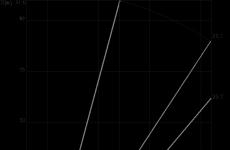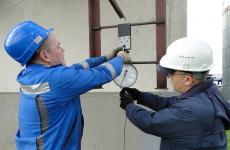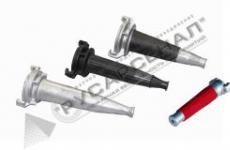Types of fire monitors. Fire monitors are divided into stationary (C) (on a fire truck, tower), portable (B) (on a trailer) and portable (P). Working pressure of fire monitors
Fire monitors designed to produce powerful water or foam jets when extinguishing large fires in case of insufficient efficiency of manual fire nozzles.
Fire monitors are subdivided into stationary(WITH) - mounted on a fire truck, tower or industrial equipment (for example - LS-S20U, -S40U, etc.), carried(IN)- on a trailer and portable (P) -(for example, SLK-P20, LS-P20U, LSD-20U, etc.)
In addition, stems can be universal(U)- forming a continuous and sprayed water jet with a variable angle of the torch, as well as a VMP jet, blocking, having a variable flow rate;
Without index (Y), forming a continuous water jet and a VMF jet. The index is given after the figures indicating the water consumption.
Depending on the type of control, the trunks can be remote (D) or manual(without indexU) management. The index is given after the letters LS.
An example of a fire monitor symbol LSD-S-40U Where: LS - gun barrel, D - with remote control, WITH - stationary, 40 - water consumption (l/s), U - universal.
Fire monitor portable barrel type PLS-20P - designed to create and direct a jet of water or VMP when extinguishing fires.
It consists of a receiving body, a swivel tee, a two-arm branch, a pipe, a nozzle. The receiving body is fixed on a removable support (carriage), which consists of two symmetrically curved legs with spikes.
In the receiving body there is a check swivel valve that allows you to connect and replace hose lines to the pressure pipe without stopping the operation of the shaft.
The swivel body is connected to a swivel tee, and it is connected to a two-arm branch. Swivel joints are sealed with ring rubber cuffs.
A four-way damper is installed inside the pipe body ( a device that eliminates the phenomenon of rotation of the flow of fuel coming from the sleeves into the barrel, which degrades the quality of the jet, i.e. dividing the flow cross section into several parts, helps to restore the axisymmetric distribution of velocities in the flow to a parallel-jet, not fragmented one).
To supply the VMP, the water nozzle on the pipe body is replaced with an air-foam one.
Specifications:
- nozzle diameter, mm 22 28 32
Nominal pressure, kg/cm² 6 6 6
- water consumption, l/s 19 23 30
- foam consumption, m³/min 12
- jet range, m:
Water 61 67 68
Foam 32
- mass no more 27 kg
The barrel can rotate around the vertical axis by 360º and move in the vertical plane from 32 to 75º.
Safety precautions when working with fire monitors:
Barrels must pass an annual hydraulic pressure test of 0.8 MPa;
During operation, the barrels must be regularly serviced and inspected, especially the hinges and joints;
When working, portable trunks are installed on a flat surface;
The reliability of fastening the barrel on the carriage is checked;
Work with the fire monitor is carried out by two firefighters.
Not many people understand the difference between a fire monitor and a simple fire fighter's hand gun. When it is necessary to introduce forces and means to extinguish a fire using large amounts of water, and at the same time also pointwise, this type of fire-technical equipment is most often used in divisions.
Consider the main modifications.
You can study the detailed characteristics of fire monitors by clicking on the link on the website of the manufacturer of this type of equipment: http://lafet01.ru, the project presents most of the modern models.
Stationary
(major modifications)
From the name, it immediately becomes clear that the equipment is fixed on a platform or on the roof of a fire truck. The supply of water or water-foam solution through the device is carried out using manual control by the operator. Modifications provide for the possibility of splitting the jet into continuous and sprayed, or a combined method of supplying extinguishing agents. There are models that are able to create a water curtain for the barrelman.
Pros:
- high intensity of supply of fire extinguishing agents;
- no scavenger required
Minuses:
- not mobile;
- difficult to maintain.
The main modifications differ only in characteristics. Let's analyze the abbreviation with an example fire monitor LS-S20Uze.
The letters have the following meaning:
- LS - fire monitor barrel,
- C - stationary,
- 20 - consumption of fire extinguishing agent in HP,
- Y - the ability to form different jets of OM supply, that is, universal.
- SE - the ability to create a protective screen.
There are modifications with adjustable supply of fire extinguishing agent. This is usually indicated by the manufacturer in the model name, as well as a flow rate of up to 100 liters per second.
Design
1. Support structure;
2. Barrel body;
2. Nozzles;
4. Inlet pipe mounted on the supporting structure;
5. Outlet pipe;
6. Hinge;
7. Fixing device;
8. Handle.
portable
Portable drugs are distinguished by their mobility, and the ability to supply agents where specialized equipment cannot pass. Back in the days of the USSR, the most popular model was the PLS-P20, which are still used by the firefighters of our country, progress is changing, and soon we will no longer see its use on fire.
Modern portable fire monitors have such modifications as: Fire monitor LS-P20Uze. The designation of letters is similar to the example written above, but with one clarification. In this case, the letter "P" stands for portable.

There are almost no changes in design features, a device of this type includes:
- barrel body;
- pressure pipes;
- receiving body with a half-nut;
- retainer;
- handles for controlling the mechanism;
- platform (base).
Pros:
- mobile;
- light weight;
- easier to maintain.
Minuses:
- time of filing, deployment and installation of the barrel;
- site selection for installation;
- under high pressure, instability is possible.
Despite some disadvantages, most firefighters give more preference to this type of fire-technical equipment than to stationary drugs, since the possibilities for supplying fire extinguishing agents are more effective.
Stationary with remote control
Modifications of trunks with the designation of remote control in a simpler language, with remote control. This type of fire protection equipment is used at strategically important facilities, industrial enterprises. They have proven themselves especially well at serving oil rigs, as well as oil refining bases. The use of a fire monitor with remote control is caused by a direct threat to personnel.
The design is similar to that of a stationary LS, but with a control unit and a mechanism that sets the barrel in motion.
The device management process is very simple. The operator can change the type of jet, the angle of inclination, flow rate, as well as the direction of the barrel itself using a radio channel or cable line, thereby eliminating the impact of fire hazards.
The main models on the market have the designation: LSD-S20U (water flow from 20 to 60 liters per second.)
Pros:
- no scavenger required.
Minuses:
- price;
- difficult to maintain;
- not mobile.
robotic
In other words, Robotic - the purpose is similar to remote-controlled drugs. In the world more and more preferences are given to such modern equipment. As previously mentioned, this type of fire extinguishing equipment is simply necessary when extinguishing fires with a great risk for the personnel of the units.
Remote control and monitoring of the situation, these are the main advantages over standard fire monitors. It is worth noting that the equipment market changes every code and more and more advanced models equipped with video cameras, thermal, infrared sensors and other innovations appear. Many models presented for sale have explosion protection, not to mention dust and moisture resistance.
The main task of the application: localization and elimination of a fire in the size that it took before the introduction of extinguishing agents. Specialized software, with the help of which the equipment is configured, allows you to determine the necessary parameters in each case for extinguishing.
As with younger brothers, water and foam are used to extinguish. It is capable of extinguishing both automatically and manually up to 15 thousand square meters, depending on the intensity of the supply of fire extinguishing agent, according to the commands given by the operator. The design of such a shaft is regulated by established standards in accordance with GOST.
Applies to objects:
- warehouses;
- chemical and oil industry;
- in seaports;
- at other critical facilities.
Pros:
- protection of personnel from OFP;
- high efficiency;
- high intensity of supply of fire extinguishing agents;
- no launcher required;
- wide range of applications.
Minuses:
- price;
- difficult to maintain.
Manual and fire monitors (SP) - removable parts with a nozzle, nozzles, casings, fasteners, controls at the ends of fire pressure (working) lines and hoses.
Norms:
- GOSTs:
Purpose of trunks
SP is the end of the pressure line with the following functions:- creation of the required jet format;
- giving direction to the fire extinguishing agent (OTV);
- convenient fixation in hands, on technical means;
- supply and flow control.
- fire trucks, pump-sleeve vehicles, tank trucks;
- fixed and mobile fire extinguishing installations;
- sleeves on PC, risers, ;
- special automatic/autonomous extinguishing systems.
Types of fire extinguishing trunks
There is a variety of fire extinguishing equipment. Several types of hoses have been developed for different specifications:Separation factor | |
|
|
Serve breaks |
|
Functions and type of OTV |
|
Application area |
|
Climatic performance | By for different zones. |
Device:
- body with nozzle:
- aluminum;
- cast iron (less often);
- plastic;
- steel elements (typical for fire monitors);
- end for binding or sleeve (GR) from Al, brass, plastic:
- coupling;
- tsapkovy;
- transitional;
- plug;
- suction;
- inside:
- sedative;
- tangential channels leading to the nozzle;
- decor:
- shoulder strap;
- braid;
- lever;
- a node with a lever and a plug valve, if there is an opening / closing function;
- for combined and foam - casing, foam generator;
- monitors:
- removable carriage, tripod;
- pressure pipe;
- receiving body with a hinged valve for connecting hoses without stopping work;
- locking device on the swivel;
- for control: swivel tee, long T-handle, lever, holders;
- inside 4-blade damper.
Hand barrels
Standard models of hand barrels:- RS-50, RS-50P, RS-70 - for a continuous jet, replaceable;
- RS-50.01, RS-70.01 - non-replaceable;
- RSP-50, RSP-70, RSK-50 - overlapped. They allow you to create a release in the form of a torch, use foam nozzles;
- RSKZ-70 - multifunctional, simulating the intensity of supply, work with any substances, for p / n water supply;
- SVPE, SVPR - foam;
- improved modern trunks Protek, SelectFlow, ProJet.

Fire monitors
Fire monitors - long adjustable, fixed on surfaces or equipment fire hoses (LSD-S-40U, PPS-20P) with a complicated design with rotation. Example: a model with a two-horn fork near the gun carriage.Varieties:
- portable (P);
- remote (D) - machines must have a remote control system;
- stationary (C) - mounted on vehicles, on towers. Connect to or fire engine pumps;
- transportable (B) with a large angle of rotation, mounted on a trailer.

Fire extinguishing barrels A and B: what is it
Manual joint ventures are divided by the ability to serve intermittently. On the territory of the CIS they are designated by letters:Classification of trunks by type of OTV
Pumps are designed for water or foam, less often - for powder, gas. Some samples work with two types of extinguishing agent at the same time, using special nozzles.Water
Fire nozzles under water do not have special nozzles for creating foam and calibrating it (generators). They form jets of different parameters - sprayed, solid, curtains.Foam
Air-foam hoses (SVPE, SVP) create VMP of high, medium, low expansion:- A special chemical substance comes from a knapsack tank just before release.
- Air and composition are ejected (sucked in) by a system of holes in the nozzle - bubbles are created, which are calibrated by meshes.
- ejector casing;
- 3 cameras:
- reception;
- vacuum with a nipple (16 mm) for a foam concentrate suction hose;
- day off.
- The foaming agent enters the receiving part.
- A vacuum is created in the vacuum segment, sucking air through 8 holes in the casing.
- The air is mixed with the substance, forming a VMP at the outlet.
- The mixture is fed into the atomizer by a sleeve.
- Separate drops are formed.
- The conglomerate moves to the calibration grid, sucking in and mixing with air.
- Bubbles appear.
- The mass from the nozzle is pushed out by the energy of new drops.
In SVPs, packages of calibration grids are important - they need to be regularly inspected and cleaned, as the cells become clogged.
Universal
Multifunctional fire extinguishing trunks (RSK-50, RSP-50.70, RSKZ-70) for water allow the valve handle to control the release, creating a continuous flow, spraying, protective curtains (by 120 °). In addition to the lever, various removable nozzles affect the process.Work example:
- The liquid enters the tangential channels.
- Further - in the central nozzle.
- It comes out in a swirling stream.
- OTV is sprayed under centrifugal force, creating a torch-shaped canopy with a certain opening angle (standard 60°).
Combined
Combined hoses (ORT-50) are multifunctional, they work with both foam and water. As a rule, they have a vertical handle-holder. The barrels of the combined type are equipped with a variety of removable couplings, casings, generators, according to the desired output parameter. They allow you to create all types of jets, VMP multiplicity.TTX of fire extinguishing trunks
When evaluating a product, analyze:- consumption;
- range (simple and effective);
- irrigation intensity;
- angle, diameter of the torch;
- foam ratio;
- parameters of the device itself (weight, length, diameter).
barrel type | Water consumption, l/s | Jet range (compact), m | Spray diameter, mm | Barrel length, mm | Weight, kg |
Extinguishing depth
The quenching depth is the maximum distance of the fire extinguishing agent supply from the nozzle while maintaining efficiency. An important parameter for water trunks. Only about a third of the length of the compact release is effective.Depth of processing (h) - the main value in calculating the area of quenching. When firefighting with hand-operated hoses ht = 5 m, fire-fighting - 10 m.
Water consumption
The number of joint ventures on fire and personnel depends on the consumption of OTV. The value affects the calculation of the capabilities of pumping hose equipment - the amount of water spent through a certain section of the nozzle depends on the pressure drop.Calculations are important to determine the performance at different practically significant pressure (0.3 - 0.9 MPa). This is important when replacing devices: for example, at 0.4 MPa, the RS-50 produces 3.6 l / s, KURS-8 - up to 8 l / s. The TD has tables of standard values at a certain pressure.
Barrel head, m | Water consumption, l / s, from the barrel with nozzle diameter, mm |
||||||
Extinguishing area
It is often impossible to apply OTV immediately to the entire hearth, then they extinguish the front, where they get it. The flame is localized in decisive directions - then they move on to other foci.The extinguishing area is called the effective jet coverage area: circular, triangular, rectangular. The parameter is important for tactics and directly depends on the fire extinguishing range. Since the extinguishing depth is 5 and 10 m for hand-held and fire monitors, the coverage area for them, introduced towards, will be 10 and 20 m.
Types of nozzles for barrels
Nozzles with different tip spray diameters increase functionality. Options:- for feeding intermittently and non-overlapping;
- foam, water;
- powder;
- cylindrical, conical;
- turbine, slotted;
- for fire monitors, handicrafts.
Typically, nozzles are used for foam models of barrels, since a special design is required for the required consistency of OTV. The casing has holes, swirlers, different degrees of narrowing.
Calculation of the number of trunks for extinguishing a fire
The number of technical devices for supplying OTV is calculated by special formulas. Before applying the final equation, the extinguishing parameters are known:- square;
- perimeter;
- front;
- flow rate, performance factor (nozzle conductivity).
Values |
|
For water hoses:
|
|
Foam generators (surface extinguishing):
|
|
Multiple foam generators (bulk):
|
|
Rules for working with trunks
Personnel must be instructed. When working with a fire hose, you must follow the basic rules:- position - at the level or above the focus;
- hold it correctly: with the right hand near the connecting head, with the left - by the braid, at 0.6 MPa and more, a grenade launcher is required;
- follow the grounding;
- apply to visible structures, and not according to smoke;
- apply to where the largest flame is, but also maneuver, limiting the spread of fire;
- do not leave fire on the way;
- lay the sleeve in areas that are safe for it;
- extinguish vertical objects from top to bottom, but in rooms, ventilation ducts direct fire extinguishers first of all to the ceiling or from the side of the greatest extent of voids;
- extinguish first what could collapse, taking a position, if possible, in the openings;
- cracking structures, cool gas cylinders gradually;
- extinguish glass with a spray jet;
- neighboring objects to process first from above;
- it is necessary to lower or block the hose when changing;
- the strongest cooling is created where the foam will be supplied;
- avoid icing of traffic routes, fire equipment;
- when extinguishing foam liquid substances:
- apply to the hearth only when a good consistency is reached and so that the OTV does not burrow into the thickness of the substance;
- at one point so that the foam spreads, gradually covering the hearth;
- continuous release near open power lines is prohibited;
- Work at height is carried out according to the following standards:
- the shoulder belt is not put on when lifting and extinguishing on high-rise, objects with an unsecured line, until reaching the position;
- 2 people work with insurance;
- work on the fire escape - only after fixing the belt carabiner;
- the extinguishing composition is fed gradually, gradually increasing the pressure.
- it is forbidden to leave the fire nozzle unattended at the place of the fire, even if it is blocked.
Technical regulation requirements
According to Art. 129 is the minimum that a fire nozzle must provide:- flow continuous or sprayed;
- uniformity of the FTV along the cone;
- smooth transition from compact to spray;
- flow rate adjustment without interruption of supply;
- reliability, tightness of the case under working loads;
- fixing devices with carriages vertically;
- control at the same time manual and at a distance of fire monitors by electric, hydraulic drive;
- foam generators must provide all types of expansion.
How barrels are tested
Barrels are tested once a year:- inspection;
- tightness, strength - 2 min. at operating pressure with leakage measurement;
- checking the progress of the nodes with a dynamometer;
- interchangeability of parts, interchangeability of heads;
- integrity, dispersion, angle, diameter of the torch, protective curtain (visually);
- consumption, jet length;
- thread, reliability.
Designations of fire extinguishing trunks on the diagrams
The need for the designation of trunks arises when creating diagrams (drawings) of fire extinguishing tactics. A schematic drawing is used:Designation |
|
Manual, with nozzle 19, 25 mm. |
|
With fine spray release. |
|
OTV with additives. |
|
Foam multiplicity:
|
|
For electrical installations. |
|
Monitored:
|
|
For fire hoses, common PB signs for inventory are used. The device is always available with fire hydrants, which are denoted by PC, sign F02 (sleeve and valve), less often the image of the "snail" of the sleeve with the joint venture is used.
Classification of fire monitors:
U - universal, forming a continuous and sprayed water jet with a variable angle of the torch, as well as a jet of air-mechanical foam, overlapping, having a variable flow rate;
Without index Y - forming a continuous jet of water and a jet of air-mechanical foam.
The index is given after the figures indicating the water consumption.
Depending on the type of control, the trunks can be remote (D) or manual (without the D index) control. The index is given after the letters LS.
An example of a fire monitor symbol: LSD-S-40 U ,
Where LS - gun barrel, D - with remote control, WITH - stationary, 40 - water consumption (l/s), At - universal.
Fire monitor portable barrel type PLS-20 P comprises receiving body with two pressure nozzles, equipped swing check valves, barrel tube body, control handles and locking device for moving the barrel in a vertical plane. Inside the barrel tube body is installed four-bladed damper. The trunk has three water nozzles with a diameter of 25, 28, 32 mm and an air-foam nozzle. At a nozzle pressure of 6 atm, the water flow rate is 17, 21, and 28 l/s, respectively, and the jet range is up to 60 meters. The productivity of the barrel with a foam nozzle is 12 m 3 /min, the range of the jet is 32 meters at a pressure of 6 atm. The barrel can rotate around the vertical axis by 360 degrees and move in the vertical plane from 30 to 75 degrees. The weight in assembled form is not more than 32 kg. The main parts are made of aluminum alloys. The service life of fire monitors is at least 10 years, the warranty is 1 year from the date of manufacture or 1.5 years from the date of sale.
During operation, fire monitors of all types require careful care and observation, especially hinges and threaded connections. Fire monitors are subjected to a hydraulic test at least once a year. Fire monitors are installed on a flat surface, the work is carried out by two firefighters.
The NLS-20 fire monitor attachment is designed to upgrade existing fire monitors of the PLS-PK20, SPLK-20P, SPLK-20 types in order to expand the performance characteristics.
The universal fire extinguishing complex KPTU-20 is designed to upgrade the existing fire monitors of the PLS-PK20, SPLK-20P, SPLK-20 types in order to expand the performance characteristics. Includes nozzles for the fire monitor, handle and control rods, removable foam generator.
Ticket number 7 Question 2 Cooling the combustion zone or burning substance; flame cessation mechanism; fire extinguishing agents used: types, fire extinguishing characteristics, scope, application technique for extinguishing a fire
In the practice of extinguishing fires, the following principles of cessation of combustion are most widely used:
1) isolation of the combustion source from air or reduction, by diluting the air with non-combustible gases, of the oxygen concentration to a value at which combustion cannot occur;
2) cooling of the combustion center below certain temperatures;
3) intense deceleration (inhibition) of the rate of a chemical reaction in a flame;
4) mechanical breakdown of the flame as a result of exposure to a strong jet of gas and water;
5) creation of fire barrier conditions, i.e. such conditions under which the flame propagates through narrow channels.
The fire extinguishing ability of water is determined by the cooling effect, the dilution of the combustible medium by the vapors formed during evaporation and the mechanical effect on the burning substance, i.e. burst of flame. The cooling effect of water is determined by the significant values of its heat capacity and heat of vaporization. The dilution effect, which leads to a decrease in the oxygen content in the surrounding air, is due to the fact that the volume of steam is 1700 times the volume of evaporated water. Along with this, water has properties that limit the scope of its application. So, when extinguishing water, oil products and many other combustible liquids float up and continue to burn on the surface, so water may be ineffective in extinguishing them. The fire-extinguishing effect when extinguishing with water in such cases can be increased by supplying it in a sprayed state. Water containing various salts and supplied by a compact jet has a significant electrical conductivity, and therefore it cannot be used to extinguish fires in objects whose equipment is energized. Extinguishing fires with water is carried out by water fire extinguishing installations, fire trucks and water guns (manual and fire monitors). To supply water to these installations, water pipes installed at industrial enterprises and in settlements are used. In case of fire, water is used for external and internal fire extinguishing. Water consumption for outdoor fire extinguishing is taken in accordance with building codes and regulations. Water consumption for fire extinguishing depends on the fire hazard category of the enterprise, the degree of fire resistance of the building structures of the building, and the volume of the production facility. One of the main conditions that external water pipes must satisfy is to ensure constant pressure in the water supply network, maintained by constantly operating pumps, a water tower or a pneumatic installation. This pressure is often determined from the operating conditions of indoor fire hydrants. In order to ensure the extinguishing of a fire in the initial stage of its occurrence, in most industrial and public buildings, internal fire hydrants are installed on the internal water supply network. (Besides this, see ticket #5 question 2 and ticket #6 question 2)
Fire monitor trunks- these are barrels intended for the formation of continuous or continuous and sprayed jets of water with a variable angle of the torch, as well as jets of low expansion air-mechanical foam.
Classification
Combined fire monitors are divided into 3 main groups.
Depending on the type of transportation:
- portable (P)– are transferred manually;
- Transportable - mounted on a trailer (IN);
- Stationary - mounted on a fire truck.
Kinds
portable
PLS-20P
The portable fire monitor PLSP-P20 consists of a body (1), pressure nozzles (3), a receiving body (5), and a control handle (6).
The receiving body has a swivel check valve that allows you to connect and replace hose lines to the discharge pipe without stopping the operation of the shaft.
A four-bladed damper is installed inside the body (1) of the barrel pipe.
To supply the VMP for the formation of a water jet, the nozzles on the body are replaced with nozzles for the formation of medium expansion foam (2).
When changing the water nozzle, the consumption of fire monitors changes.
Fire monitor ML-P20
Designed to form and direct a direct compact or sprayed jet of water or a wetting agent solution.
The monitors have stepless adjustment of the spray jet angle from a direct compact jet to a protective curtain of 120 0, which is carried out by turning the handwheel of the nozzle.
- Water consumption not less than 20 l/s.
- The range of the water jet is not less than 70m.
Stationary
Modern universal fire monitors have a more compact design with a system for supplying a spray jet of fire extinguishing agent. The design of curved hollow bodies of revolution allows you to freely manipulate the flow direction with a flow rate of 20 to 150 l/s at a pressure of up to 1.6 MPa (150 l/s - water supply to the entire city district).
Let's take a closer look: Let's pay attention to the appearance of these trunks, such a zigzag shape allows us to exclude (prevent) the effect of "jet thrust".
This effect occurs when the flow of water comes out of the trunk in a straight line, so there is such a thing for trunks with a large flow rate as a sub-stemer (a person who ensures the stability of the main stemmer).
The zigzag shape of the barrels makes it possible to refract the energy of the flow from the liquid and facilitate the manipulation of the barrel by its operator, which greatly simplifies the task during operation.
Since this is an advantage, most fire monitor manufacturers adhere to this technology.
At the end it has a nozzle, with the help of which it is possible to form both compact and sprayed jets when supplying fire extinguishing agents, as well as water curtains.
The name combined and universal makes us understand the possibility of using this type of barrels not only with water, but also when supplying foam.
Characteristics
The table shows the performance characteristics of fire monitors LS-S20U, LS-S30U, LS-S40U, LS-S50U, LS-S60U, such as foam ratio, foam concentrate solution consumption, water jet range (including continuous foam), weight, service life years.
Additional material:
robotic
PR-LSD-S40U-IR-TV
The fire-fighting robot based on fire monitors is stationary, water-foam, universal, with software (remote) control, with a fire detection device, with a television camera is designed to form a stream of sprayed mass of fire extinguishing agent “JF” with a variable spray angle from a direct cumulative jet to a protective screen (90 deg.)
JF - JET FOG(flying fog effect) - there is a very strong spraying of the flow of fire extinguishing agent (cumulative jet). When extinguishing a fire, the larger the area where the interaction of the extinguishing agent occurs, the more effectively it is extinguished.
Marking decoding:
- PR - fire robot;
- LSD - fire monitor with remote control;
- S40U - stationary with a flow rate of 40 l / s universal;
- IR - with an infrared sensor for detecting the source of combustion;
- TV - equipped with a TV camera.
The features of the barrels are that they are remotely controlled and are mainly used at especially fire hazardous facilities, to eliminate the likelihood of a threat to the life of the operator.
Additional material
Sources:
- Federal Law of the Russian Federation No. 123-FZ of August 7, 2008 "Technical Regulations on Fire Safety Requirements".
- GOST R 51115-1997 Fire fighting equipment. Trunks fire monitors combined. General technical requirements. Test methods.
- Terebnev V.V. Handbook of the head of fire fighting. Tactical capabilities of fire departments. M. -2004
- Youtube channel: Fire equipment.










